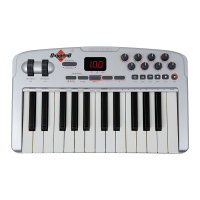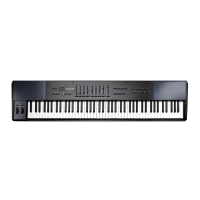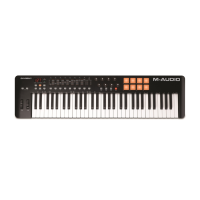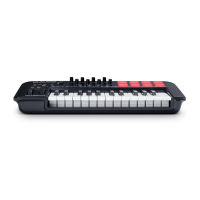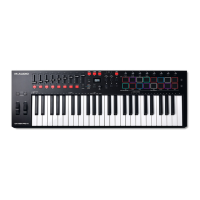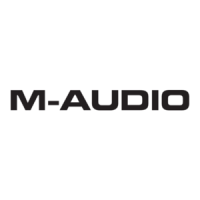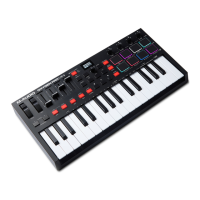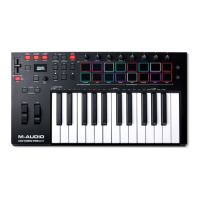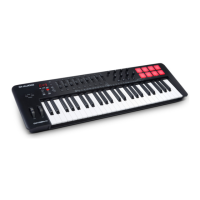
Do you have a question about the M-Audio Oxygen Series and is the answer not in the manual?
| Velocity-sensitive keys | Yes |
|---|---|
| Pitch bend and modulation wheels | Yes |
| Octave up/down buttons | Yes |
| Assignable knobs, sliders, and buttons | Yes |
| Connectivity | USB |
| Keyboard | 25, 49, or 61 keys depending on model |
| Power source | USB |
| DAW Compatibility | Ableton Live, Logic Pro, Pro Tools, FL Studio, Cubase |
| Features | Arpeggiator |
| Compatibility | Windows, macOS |
| Included software | Pro Tools First |
| Type | MIDI controller keyboard |
Lists the items included in the Oxygen Series keyboard packaging.
Details keyboard size and key sensitivity.
Explains automatic control mapping for DAWs.
Highlights advanced programming capabilities.
Describes the function of octave and transpose buttons.
Explains the function of track select buttons.
Details the sliders and their re-assignable nature.
Describes additional buttons and their re-assignability.
Details the knobs and their re-assignable nature.
Explains pitch and modulation wheels and re-assignability.
Details the transport buttons and their re-assignable nature.
Describes the sustain pedal input and re-assignability.
Mentions 10 user-editable memory locations.
Describes the 3-digit LED screen for information display.
Details the USB 2.0 port and its compatibility.
States where to find system requirements.
Explains keyboard's class-compliant USB functionality.
Details when Windows users need to install drivers.
Outlines steps for downloading and installing drivers.
Guides on responding to Windows logo testing warnings.
Instructs on connecting the keyboard after driver installation.
Details the driver search process in Windows XP.
Explains the steps within the Found New Hardware Wizard.
Provides instructions for Mac OS X users.
Guides on configuring recording software for MIDI input.
Explains how DirectLink maps controls to DAW functions.
Details the steps to install DirectLink support files.
Guides on configuring DAW software for DirectLink use.
Specific configuration steps for Pro Tools 8.
Instructions to load Preset 10 for DirectLink.
Explains how to map controls for unsupported DAWs.
Describes the pitch bend wheel and its MIDI capabilities.
Explains the modulation wheel and its MIDI capabilities.
Details DirectLink and standard operation of track buttons.
Explains octave shifting and transpose functionality.
Describes the 3-digit LED screen's purpose.
Details the functions of the five dedicated buttons.
Explains DirectLink and standard operation of sliders.
Details DirectLink and standard operation of slider buttons.
Explains DirectLink and standard operation of knobs.
Details DirectLink and standard operation of transport buttons.
Explains keyboard velocity and its use for programming.
Describes Kensington Lock, On/Off, Sustain Pedal, and USB ports.
Explains how to select controls for editing.
Details assigning controls and data parameters.
Explains assigning controls to specific MIDI channels.
Describes setting the global MIDI channel.
Explains sending Program Change MIDI messages.
Details bank change messages for sound selection.
Explains sending an "All Notes Off" message.
Guides on changing keyboard touch sensitivity.
Explains the reversed slider operation for organ sounds.
Describes sending preset memory locations to DAW.
Explains assigning a unique SysEx Device ID.
Details saving control assignment settings to memory.
Explains programmable MIDI CC numbers and their range.
How to configure buttons/pedals for toggle mode.
How to configure buttons/pedals for trigger mode.
Explains assigning buttons for MIDI Machine Control.
How to configure buttons to send Note On/Off messages.
Sending combined messages for patch selection.
Programming buttons to step MIDI CC values.
Programming buttons to step through program numbers.
How to reverse the direction of knobs/sliders.
How to set specific min/max values for controls.
Assigning RPN/NRPN messages to controls.
Covers SysEx message transmission and Device ID.
Explains how settings are stored.
Instructions on resetting the keyboard to factory defaults.
Explains how program and bank change messages work.
Defines Registered and Non-Registered Parameter Numbers.
Advises checking device documentation for RPN/NRPN lists.
Explains using CC 6 or CC 38 to alter RPN/NRPN values.
Illustrates combined coarse and fine message resolution.
Explains System Exclusive messages and their usage.
Steps to resolve the keyboard suddenly stopping.
Addresses issues with the computer not recognizing the keyboard.
Guides on resolving issues with no sound output.
Explains how to reduce audio latency.
Resolves issues with the sustain pedal working in reverse.
Addresses issues with recalling the wrong sound preset.
Instructions on resetting the keyboard to factory defaults.
Warns about potential malfunctions due to ESD and interference.
States compliance with FCC standards and potential voiding of authority.
Provides measures to correct radio/TV reception interference.
Outlines M-Audio's warranty coverage for defects.
Explains the advantages of registering the product.
Provides contact information for documentation feedback.
Lists standard MIDI CC numbers and their functions.
Details assignable MIDI CCs for sliders, knobs, buttons, and pedals.
Provides MIDI note numbers and General MIDI data.
Lists DirectLink transport control assignments for Pro Tools 8.
Provides a chart for converting hexadecimal to decimal values.
Lists NRPN messages for Roland GS and Yamaha XG.
Lists General MIDI reverb and chorus type definitions.

